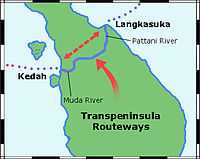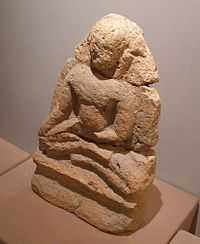Kedah Sultanate
| Part of a series on the | ||||||||||||||||||||||||||||
| History of Malaysia | ||||||||||||||||||||||||||||
|---|---|---|---|---|---|---|---|---|---|---|---|---|---|---|---|---|---|---|---|---|---|---|---|---|---|---|---|---|
 |
||||||||||||||||||||||||||||
| Prehistoric Malaysia | ||||||||||||||||||||||||||||
| Early kingdoms | ||||||||||||||||||||||||||||
|
||||||||||||||||||||||||||||
| Rise of Muslim states | ||||||||||||||||||||||||||||
|
||||||||||||||||||||||||||||
| Colonial era | ||||||||||||||||||||||||||||
|
||||||||||||||||||||||||||||
| Independence era | ||||||||||||||||||||||||||||
|
||||||||||||||||||||||||||||
| By topic | ||||||||||||||||||||||||||||
| Timeline | ||||||||||||||||||||||||||||
|
|
||||||||||||||||||||||||||||
| History of Thailand |
|---|
 |
| Prehistory |
| Early history |
|
Legendary Suvarnabhumi Central Thailand Dvaravati Lavo Supannabhum Northern Thailand Singhanavati Ngoenyang Hariphunchai Southern Thailand Pan Pan Raktamaritika Langkasuka Srivijaya Tambralinga Nakhon Si Thammarat Sultanate of Pattani Kedah Sultanate |
| History |
|
Sukhothai Kingdom Ayutthaya Kingdom Thonburi Kingdom Rattanakosin Kingdom Military period Democratic period |
|
Regional history |
|
Related topics |
The Sultanate of Kedah was the earliest sultanate on the Malay Peninsula and one of the oldest Sultanates in the world, founded in 1136.
Kedah Kingdom


Kedah Kingdom (630-1136) was founded by Maharaja Derbar Raja of Gemeron around 630 CE and the Hindu dynasty ended when Phra Ong Mahawangsa converted to Islam.
History
Around 170 CE a group of native refugees of Hindu faith arrived at Kedah, joining them soon were peoples from nearby islands and from the northern Mon-Khmer region. Ancient Kedah covered the areas of Kuala Bahang, Kuala Bara, Kuala Pila and Merpah, and the inhabitants of Kedah appointed Tun Derma Dewa and Tun Perkasa as their village chiefs.
The king from Gemeron
In 630 CE, Maharaja Derbar Raja of Gemeron (now known as Bandar Abbas) in Persia was defeated in battle and escaped to Sri Lanka, and he was later blown off course by a storm to the remote shores of Kuala Sungai Qilah, Kedah. The inhabitants of Kedah found him to be a valiant and intelligent person, and they made him the king of Kedah. In 634 CE, a new kingdom was formed in Kedah consisting of Persian royalty and native Malay of Hindu faith, the capital was Langkasuka.
Conversion to Islam
In the late 11th century, after the Chola military left Kadaram, the 9th Hindu rajah, Dubar Raja II, renounced Hinduism and converted to Islam, which was introduced by Muslims from neighbouring Aceh, he also changed his name to Sultan Mudzafar Shah. He ruled the northern region of Malay Peninsula from 1136 to 1179. According to the Kedah Annals, the first king of Kedah was Maharaja Derbar Raja I, a fleeing king from Gameron in Persia.
List of rulers
According to tradition, the founding of the Kedah kingdom (or Kadaram) occurred around 630 CE, replacing the ancient kingdom of Langkasuka. It is said to have been founded by Durbaraja I, a Hindu who originated from Gemeron in Persia. The Hindu dynasty ended when the ninth king Durbaraja II, styled "Phra Ong Mahawangsa" by the Siamese, converted to Islam in 1136.[1]
Hindu era
The following is a list of kings of Kadaram, nine in total. Each used the Hindu title of maharaja. The exact dates of each king's reign are not known.
- Sri Paduka Maharaja Durbar Raja I (c. 630–?)
- Sri Paduka Maharaja Diraja Putra
- Sri Paduka Maharaja Maha Dewa I
- Sri Paduka Maharaja Karna Diraja
- Sri Paduka Maharaja Karma
- Sri Paduka Maharaja Maha Dewa II
- Sri Paduka Maharaja Darma Raja
- Sri Paduka Maharaja Maha Jiwa
- Sri Paduka Maharaja Durbar Raja II (?–1136; succeeded as Sultan of Kedah, see below)
- Source for the list of sultans is the Muzium Negeri Kedah, Alor Setar, Malaysia. "The sultans of Kedah".
Islamic era
The beginning of the use of the title sultan in Kedah is attributed to a visit by a Muslim scholar from Yemen, Sheikh Abdullah bin Ja'afar Quamiri, to Durbaraja II's palace at Bukit Mariam in 1136. The audience resulted in the king's conversion to Islam. He adopted the name "Mudzafar Shah" and established the sultanate of Kedah, which continues to rule today.[1]
- Source for the list of sultans is the Kedah State Public Library (2003). "The genealogy of His Highnesses". Our Sultan. Retrieved 2010-08-29.
Culture
Nobat
The Nobat musical instruments of Nagara and Nepiri were introduced to Kedah by Maharaja Derbar Raja. The instrument is also called semambu. The band is led by the king, and it consists of drums, a gong, a flute and a trumpet. Today, Nobat is a Royal orchestra, played only during royal ceremonies such as inaugurations, weddings, and funerals. The building which houses the instruments and where the ensemble rehearses is known as the Balai Nobat, literally the Office of Nobat.
See also
- Bujang Valley
- Hikayat Merong Mahawangsa
- Sultanate of Johor
- Sultanate of Malacca
- Sultanate of Singgora
- List of Sunni Muslim dynasties
Notes
- ↑ 1.0 1.1 "Kedah: Intro and Background". Go2Travelmalaysia.com. Capslock Sdn Bhd. Retrieved 2011-03-04.
References
- Mohammad Isa Othman, Politik Tradisional Kedah 1681–1942, Dewan Bahasa dan Pustaka, Kuala Lumpur, 1990
External links
- List of Kedah sultans
- (Malay)Nobat
| ||||||||